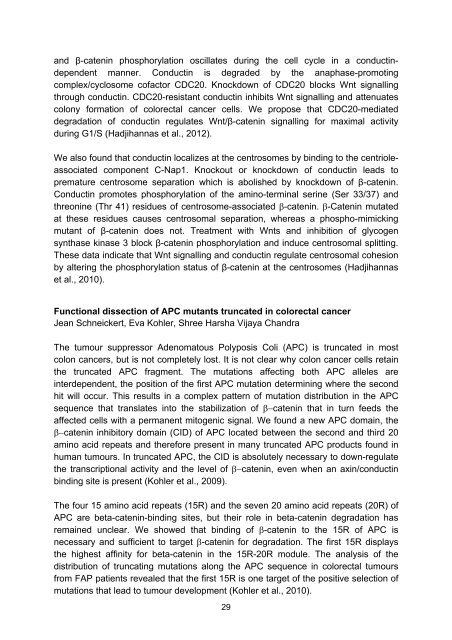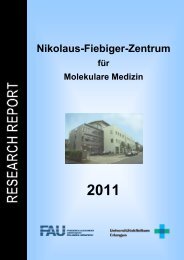Research Report - Nikolaus-Fiebiger-Zentrum für Molekulare Medizin
Research Report - Nikolaus-Fiebiger-Zentrum für Molekulare Medizin
Research Report - Nikolaus-Fiebiger-Zentrum für Molekulare Medizin
Create successful ePaper yourself
Turn your PDF publications into a flip-book with our unique Google optimized e-Paper software.
and β-catenin phosphorylation oscillates during the cell cycle in a conductindependent<br />
manner. Conductin is degraded by the anaphase-promoting<br />
complex/cyclosome cofactor CDC20. Knockdown of CDC20 blocks Wnt signalling<br />
through conductin. CDC20-resistant conductin inhibits Wnt signalling and attenuates<br />
colony formation of colorectal cancer cells. We propose that CDC20-mediated<br />
degradation of conductin regulates Wnt/β-catenin signalling for maximal activity<br />
during G1/S (Hadjihannas et al., 2012).<br />
We also found that conductin localizes at the centrosomes by binding to the centrioleassociated<br />
component C-Nap1. Knockout or knockdown of conductin leads to<br />
premature centrosome separation which is abolished by knockdown of β-catenin.<br />
Conductin promotes phosphorylation of the amino-terminal serine (Ser 33/37) and<br />
threonine (Thr 41) residues of centrosome-associated β-catenin. β-Catenin mutated<br />
at these residues causes centrosomal separation, whereas a phospho-mimicking<br />
mutant of β-catenin does not. Treatment with Wnts and inhibition of glycogen<br />
synthase kinase 3 block β-catenin phosphorylation and induce centrosomal splitting.<br />
These data indicate that Wnt signalling and conductin regulate centrosomal cohesion<br />
by altering the phosphorylation status of β-catenin at the centrosomes (Hadjihannas<br />
et al., 2010).<br />
Functional dissection of APC mutants truncated in colorectal cancer<br />
Jean Schneickert, Eva Kohler, Shree Harsha Vijaya Chandra<br />
The tumour suppressor Adenomatous Polyposis Coli (APC) is truncated in most<br />
colon cancers, but is not completely lost. It is not clear why colon cancer cells retain<br />
the truncated APC fragment. The mutations affecting both APC alleles are<br />
interdependent, the position of the first APC mutation determining where the second<br />
hit will occur. This results in a complex pattern of mutation distribution in the APC<br />
sequence that translates into the stabilization of β−catenin that in turn feeds the<br />
affected cells with a permanent mitogenic signal. We found a new APC domain, the<br />
β−catenin inhibitory domain (CID) of APC located between the second and third 20<br />
amino acid repeats and therefore present in many truncated APC products found in<br />
human tumours. In truncated APC, the CID is absolutely necessary to down-regulate<br />
the transcriptional activity and the level of β−catenin, even when an axin/conductin<br />
binding site is present (Kohler et al., 2009).<br />
The four 15 amino acid repeats (15R) and the seven 20 amino acid repeats (20R) of<br />
APC are beta-catenin-binding sites, but their role in beta-catenin degradation has<br />
remained unclear. We showed that binding of β-catenin to the 15R of APC is<br />
necessary and sufficient to target β-catenin for degradation. The first 15R displays<br />
the highest affinity for beta-catenin in the 15R-20R module. The analysis of the<br />
distribution of truncating mutations along the APC sequence in colorectal tumours<br />
from FAP patients revealed that the first 15R is one target of the positive selection of<br />
mutations that lead to tumour development (Kohler et al., 2010).<br />
29



